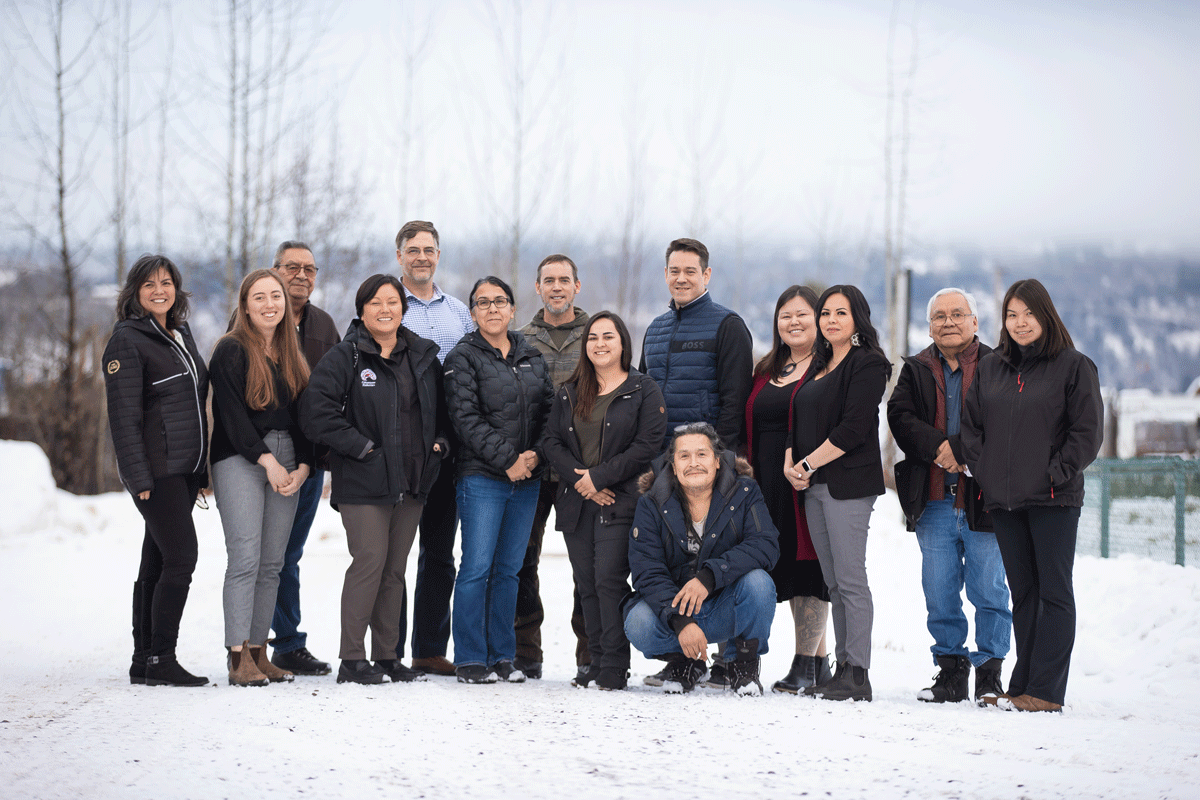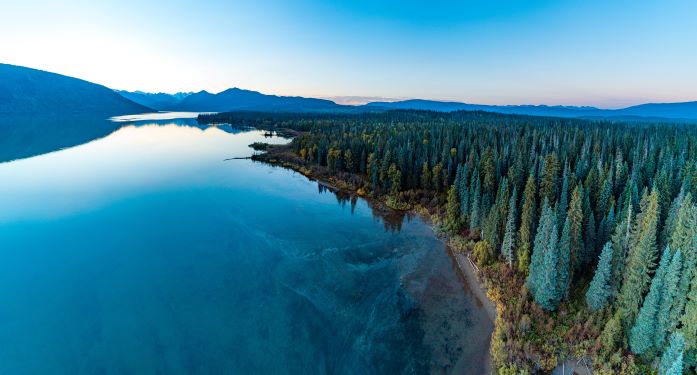
After three years of deliberations, engagement, and drafting, the Gitanyow Hereditary Chiefs established the Gitanyow Wilp Sustainability Assessment Process (GWSAP) in 2020. The GWSAP sets out requirements for a fully Indigenous-led assessment of projects in the Gitanyow Lax’yip (territories) based on Gitanyow’s own laws.
In February 2022, the Gitanyow began the assessment of the transportation route associated with the Eskay Creek Revitalization Project, a proposed open-pit gold and silver mine at the site of a previous underground mine. This is the first assessment under the GWSAP process. The proponent, Skeena Resources Limited, has agreed to be bound by Gitanyow jurisdiction and to respect the GWSAP process, marking an important accomplishment for the application of Indigenous law.
The Gitanyow have never surrendered their Lax’yip, which spans approximately 6,200 square kilometres in the Nass and Skeena River watersheds, in what is now known as northwestern BC. The Gitanyow Nation comprises two Pdeek (Clans), organized into eight Wilp. The Wilp are the primary social, political and economic unit in Gitanyow society. Each Wilp owns and has authority over its respective Lax’yip.
The GWSAP is grounded in the Gitanyow Ayookxw (Gitanyow’s Indigenous laws) and the development of modern legal and policy instruments such as the Gitanyow Lax’yip Land Use Plan. You can read more about the GWSAP and how it was developed here.
Early steps in the GWSAP process include the signing of an Initial Engagement Agreement and a Project Assessment Agreement. These agreements associated with the Eskay Creek Revitalization Project were signed by the Gitanyow Hereditary Chiefs and Skeena Resources in September 2022.
“This day is about recognition. It has been a long time coming and finally industry recognizes Gitanyow’s laws with respect to our territory and sustainable development.”
- Glen Williams/Malii, Gitanyow Hereditary Chiefs Office President and Chief Negotiator
Since this initial agreement, the relationship has continued to build through the GWSAP process with a gathering between the two parties on January 13, 2023, formally marking the launch of Skeena Resources entering the Gitanyow WSAP.
“In an era of significant and potentially devastating climate change, our process will look closely at the greenhouse gas emissions and other climate impacts associated with this project and make a determination if the company’s efforts to reach net-zero are sufficient or if there is more that can be done.”
- Tara Marsden/Naxginkw, GWSAP Lead
The Provincial government, Tahltan Central Government, and federal government are collaborating on an environmental assessment process with regard to the Eskay Creek mine as a whole, since the proposed mine site is in Tahltan territory and it requires assessment under different laws and agreements. The Gitanyow WSAP will run parallel to this other assessment work, and will focus on reviewing components of the project affecting Gitanyow territory and people, particularly the proposed industrial traffic associated with the project through Gitanyow Lax’yip.
“Our Lax’yip Guardians and fish and wildlife biologists will be assessing the potential impacts of the industrial traffic associated with this project on one of the most ecologically rich parts of the Lax’yip that is affected by the Highway 37 and 37A corridors. We have been successful in supporting the recovery of the Nass moose population, but roadkill from industrial traffic continues to be a concern.”
- Kevin Koch, Gitanyow Wildlife Biologist and Lead for the Lax’yip Guardians

The Meziadin Indigenous Protected Area in Gitanyow Lax'yip, which the transportation route will pass through for the Eskay Creek project (Credit: VoVo Productions).
Because the proposed mine itself is in Tahltan territory, rather than Gitanyow Lax’yip, the Gitanyow recognize Tahltan Central Government’s authority regarding the mine site, including Tahltan’s consent-based decision-making agreement with BC under Section 7 of the Declaration on the Rights of Indigenous Peoples Act (Declaration Act). This agreement, which is the first of its kind, specifically outlines consent-based decision-making related to the environmental assessment of the Eskay Creek Revitalization Project, meaning Tahltan Central Government’s consent is required before the project can proceed.
“The Tahltan are the ultimate decision-makers on the mine itself. While the mine requires a transportation route that crosses the Gitanyow Lax’yip, it is the Tahltan territory which will be most affected by the mine. We hope to follow the progress of the Tahltan process and have communicated support to the Tahltan for their right to free, prior and informed consent on this project.”
- Joel Starlund/Sk’a’nisim Tsa Win Giit, Gitanyow Hereditary Chiefs Office Executive Director
Through implementation of the WSAP, Gitanyow is overcoming the systemic racism of the provincial and federal environmental assessment processes, which from Gitanyow’s perspective merely rubber stamp industry plans and very rarely reject projects, respect Indigenous consent, or provide for meaningful oversight and long-term monitoring.
Participating in previous colonial government assessment processes has been a drain on human resource capacity, a source of harm and insult to Gitanyow sustainability principles, and has not resulted in meaningful outcomes for the Gitanyow. Moving beyond the colonial era requires that industry and other governments respect and uphold the Gitanyow Ayookxw in its modern form, the GWSAP.
This much-needed shift puts Indigenous laws, rights and authority at the forefront when decisions are made about the land and water – and it’s an approach that is gaining steam beyond Gitanyow Lax’yip. Gitanyow was inspired and informed by the Tsleil Waututh Nation’s independent assessment of the TMX pipeline in the Lower Mainland, as well as other First Nations that have conducted similar processes outside of colonial government environmental assessments. The Gitanyow Hereditary Chiefs look forward to completing the WSAP assessment for the Eskay project, and to ensuring the company respectfully abides by its outcomes.
Tara Marsden is a Gitanyow Wilp member who has worked for the Gitanyow Hereditary Chiefs for over a decade, first as Wilp Sustainability Director and more recently as a contractor through her own consulting business. Tara has worked closely with West Coast Environmental Law to develop and implement the GWSAP under the direction of the Gitanyow Hereditary Chiefs.
Shawn Smith is an articled student at West Coast Environmental Law. Through the RELAW program, West Coast Staff Lawyer Gavin Smith and Executive Director and Senior Counsel Jessica Clogg have provided multi-year support to the Gitanyow in creating and implementing the GWSAP.
Top photo: Gitanyow Hereditary Chiefs, staff and representatives of Skeena Resources at the launch of the GWSAP. (Credit: Camus Photography)